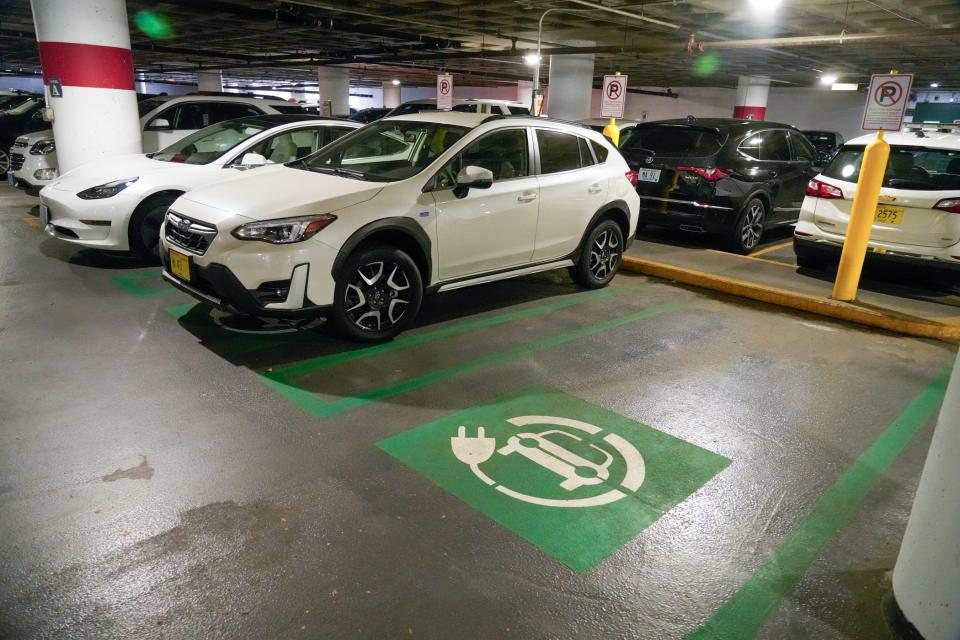Rhode Island has cut greenhouse gases by 20% since 1990 — but has a long way to go
- Oops!Something went wrong.Please try again later.
PROVIDENCE — Rhode Island has met the first interim target put in place by a landmark state climate law by reducing greenhouse gas emissions 20.1% below 1990 levels, the Department of Environmental Management reported Friday.
The level of reduction is more than double the 10% cut by 2020 mandated by the Act on Climate, the sweeping law signed by Gov. Dan McKee two years ago that forms the foundation of the state’s efforts to address climate change by electrifying cars and heating systems and ramping up the use of wind and solar power.
COVID pandemic likely responsible for large part of emissions drop
While the state was expected to meet the target and was well on track when the last batch of data was released last December, officials cautioned that a good part of the 6.5% drop in emissions from 2019 to 2020, the most recent year for measurements, was due to the COVID pandemic.
“Due to the reduced transportation activity in the first half of 2020 during the COVID-19 pandemic, the state’s emissions were significantly reduced beyond what would be typically expected,” the DEM stated. “The absence of pandemic-related social and economic restrictions in 2021 will likely translate to a rebound in emissions in the upcoming 2021 inventory, expected to be published in the fall of 2024.”

Rhode Island's air quality for 2021 still being studied
Although 2021 has already come and gone, the agency’s air quality specialists haven’t yet analyzed emissions for that year because of a three-year lag in information from the U.S. Environmental Protection Agency that is essential to the calculations in Rhode Island, as it is in other states. The delay means that there may be progress or setbacks on emissions in the meantime that have yet to be accounted for.
'We're choking': How an air quality study is mapping which PVD neighborhoods have the worst air
Next milestone will be much harder
The 10% emissions-reduction target was set years ago by state policymakers and made binding with the 2021 passage of the Act on Climate. The next target, a 45% cut by 2030, will be much more difficult to reach. Indeed, modeling by the Acadia Center and the Rocky Mountain Institute, clean energy groups working with the state, projects Rhode Island will fall just short of the target.
Their projections are based on a plan for continuing emissions cuts that was approved last year by the Executive Climate Change Coordinating Council, the state panel headed by DEM director Terry Gray that directs Rhode Island’s climate policy.
The updated plan, which was required by the Act on Climate, calls for more investments in offshore wind power, a modernization of the power grid, replacing gas-powered cars with electric models and converting heating systems that use fossil fuels to systems with electric heat pumps.
The state is actively working in each area, with a new procurement for offshore wind underway, installation of smart electric meters set to start next year, rules to phase out gasoline vehicles under consideration and new heat pump incentives in place.
Gray, in Friday’s announcement, called out the latter two sectors for change.
“Both the heating and transportation sectors remain large sources of [greenhouse gas] emissions and primary drivers of climate change,” he said in a statement. “It is critical that we remain focused on these sectors and continue our investments in renewable energy to meet our mandated emissions reductions for the future health and prosperity of the state.”
Transportation remains the largest single source of emissions in the state, accounting for 38% of the total, according to the state's greenhouse gas inventory. COVID lockdowns largely accounted for the 11.6% decrease in emissions from the sector from 2019 to 2020, according to the DEM.
Electricity consumption is the second-largest sector at 20.6% of emissions. Emissions from electric use went up 16.7% in 2020 due to the closing of the Pilgrim Nuclear Power Station in Plymouth, Massachusetts, the DEM stated.
The residential heating sector is third for emissions at 19.3%. The DEM said that heating emissions dropped 8.5% from 2019 because 2020 was warmer on average.
Over the longer term, all three sectors have seen marked declines in emissions since 1990.
This article originally appeared on The Providence Journal: Rhode Island meets first target to fight climate change

